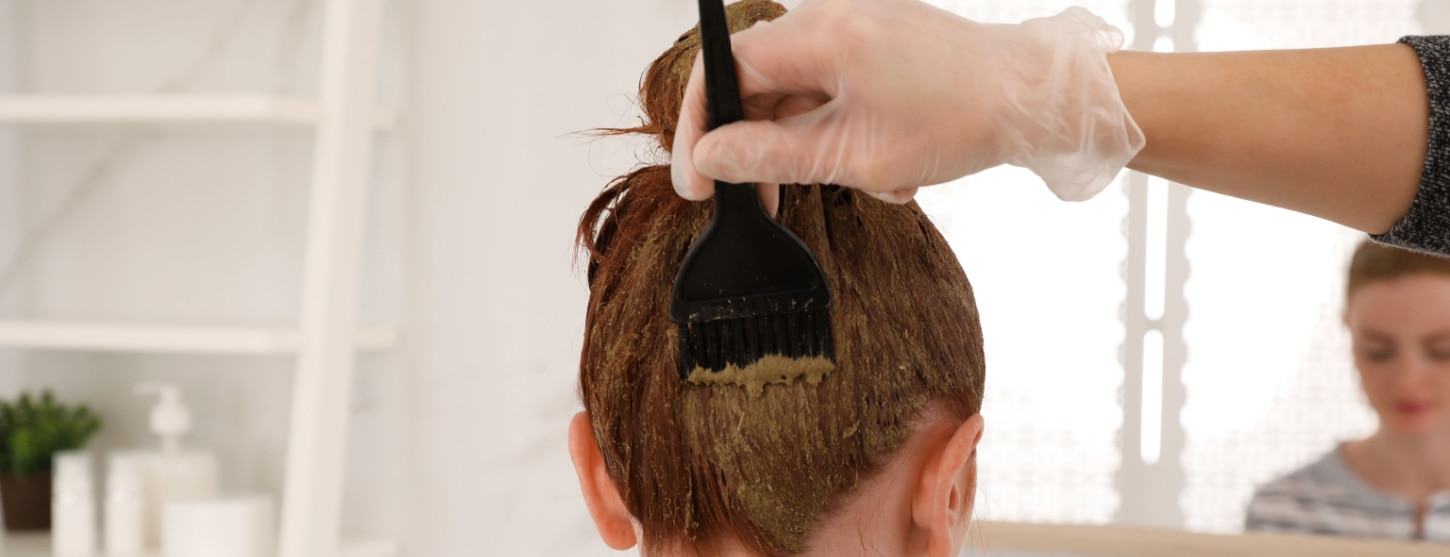15% off £20
Natural, organic, and vegan hair dye: everything you need to know

In recent years, there's been an explosion of interest in switching from harsh commercial hair dyes to more compassionate colours – both for us and the environment.
As a result, the world of natural, organic, and vegan hair dyes has become extremely exciting. The formulations available are innovative, caring and very clever.
DIY aficionados can blend their own organic hair colour with one of the many options available. If you're time-poor (or not keen on experimenting), you can use a pre-mix. Getting started can feel intimidating, though, so we spoke to the experts at Soil Association certified organic hair dye brand It's Pure to get their expert guidance on choosing the best natural hair dye options for you.
Skip to:
Why should I switch to a natural, organic, vegan hair dye?
Firstly, commercial hair colours (or box dyes, as professional colourists call them) are often extremely harsh on the hair.
Whilst choosing an organic, natural, or vegan (or best of all, all three) hair dye isn't a guarantee of safety, it’s much more likely they'll be free from harmful additives.
Common ingredients that can cause harm to your hair (and your health) include:
PPD
PPD is a chemical substance commonly found in darker permanent hair colour and other dyes. It's very effective at giving the hair a natural dark shade but can cause some unpleasant side effects. It can be allergenic, so it is banned in some parts of the world.
Mild effects can include itching and scabbing, which worsens with subsequent applications. In more serious cases, there can be swelling, severe scalp damage and even breathing issues.
Hydrogen Peroxide
Hydrogen Peroxide is an oxidative hair dye used to lighten the hair. It's permanent and actively changes the chemical makeup of your hair. Whilst this leads to longevity, it also causes huge stress for the hair, leading to hair loss and may even cause premature greying.
Ammonia
Ammonia works by roughening the hair's cuticle, allowing colour molecules to penetrate the shaft. It's very strong and is what gives box dyes that 'catch on the back of the throat' smell.
It's very allergenic, harsh on the scalp, and traces have been found in river and sea life. The replacement, MEA, is less harsh but not by much. Hair treated with ammonia can end up dry, broken and very damaged.
You may also wish to avoid silicones, sulphates, parabens, and heavy minerals in your hair colours, which may all lead to side effects.
Pro tip: Always use gloves when dyeing your hair and never apply dye without a patch test – even if you've used it before.
Handpicked content: Everything you need to know about dyeing your hair
Are all-natural hair dyes also organic and vegan?
Sadly, buying a natural hair dye doesn't mean it will be organic; likewise, being organic doesn't mean a product will be vegan.
Organic hair dye
If a hair dye is labelled natural, it just means that at least 1% of the product is plant-based. Unfortunately, many 'natural' hair dyes aren't very natural, and whilst organic is a little better, it's not guaranteed unless it has proper certification like It's Pure.
To carry the 'certified organic' logo of a reputable agency like the Soil Association, a product must contain organic ingredients wherever they exist.
Vegan hair dye
If you're looking for a vegan product, again, it can be confusing to tell. Simply being labelled 'cruelty-free' does not mean vegan. For your hair dye to be classed as vegan, it must be against animal testing and free of animal products or by-products, including things like honey.
Again, look for a logo like the Vegan Society, to be sure.
This puts a lot of responsibility on consumers to check, but the key benefit is that you’ll be using a natural hair dye that is more likely to work with your hair and scalp and not harm the planet.
Plant-based hair dye: the best option for vegan, natural and organic options
If you really want a natural hair dye that isn't full of harmful ingredients chemicals, then you might want to consider the most natural, PPD free hair dyes out there. Check them out below.
Your choices may include the following:
Henna
Made from the Lawsonia inermis plant, Henna hair dye is a lovely option for rich, bright, deeper shades.
When mixed with yoghurt or lemon juice, it comes out as a beautiful bright copper, which oxidises (settles) over about 48 hours to red. But you can easily change the tone by blending it with other ingredients, like tea and coffee (darker effect) or beetroot juice (bright red).
You can even get very subtle results depending on how long you leave it on.
Henna has been known to have cleansing and scalp-soothing properties that work with your hair, meaning it’s non-damaging and is excellent for even curly hair types.
You can either buy raw 'blocks' or 'powdered' Henna to mix, or you can purchase pre-mixed Henna like our certified organic It's Pure range.
Handpicked content: Your guide to using henna
Indigo
From the Indigofera tinctoria plant, indigo is often added to Henna to make a dark, even black shade. It gives a glossy shine and lasts for a long time.
Cassia
Sometimes called 'colourless' Henna, Cassia is great for adding golden lights to hair – when mixed with Henna, it creates a gorgeous bronze tone. On its own, it adds golden tones to very light and grey hair.
Pro tip: It's important to note that none of the natural hair dyes can lighten your hair. Henna should not be used on bleached hair, so you may need professional advice before using it.
Amla
Amla is a traditional Ayurvedic treatment. When used alone, it adds shine, prevents hair fall and promotes fullness. Mixed with Henna neutralises the redness, creating a more neutral brown colour.
Getting the best results from your hair dye
It's possible to get professional results from an organic henna-based hair dye at home. You just need to prepare.
- Leave enough time – organic dyes take a little longer, so don't do it right before a big date.
- Do both a patch test and a strand test.You're unlikely to be allergic to a henna-based dye, but it's always best to check. A strand test means no unexpected colour results (remember to let it settle for a day or so after the test).
- Prep your Henna mix the day before you need it to let it settle, and always use non-metallic tools.
- Prepare your scalp, neck, and ears with an organic barrier balm (we love Odylique Ultra Rich) to prevent staining your skin and grab some old towels to protect clothes.
- Using a comb, split your hair into four sections across the crown and your parting. Apply a thick coating of colour, and once the hair is totally saturated, wrap it in cling film or a shower cap.
- Once you've rinsed all the colour (so the water runs clear), finish with hair oil or natural conditioner through the ends to add shine.
- Remember to wait for 48 hours before further dying to allow the colour to deepen.
Remember, Henna doesn't work on bleached hair, cannot lighten hair and can be unpredictable. So always do a patch test to ensure you get the best result.
Handpicked content: Your guide to using semi-permanent hair dye
About It’s Pure
It's Pure offers beautiful natural hair colours, stress-free. All their pre-mixed dyes and hair dye ingredients come with full instructions, gloves and shower cap and are:
• Free from PPD, GMOs, metal contaminants, or artificial additives of any kind
• The only hair dye certified organic by the Soil Association
• 100% natural, vegan, and cruelty-free
About the Author
Kirsty Lemare is the Head of Content for It's Pure and the writer of their colour guides and how-to’s. She's passionate about the fun and freedom changing your hair colour can bring and wants everyone to know how to enjoy that without harming their hair, health, or planet.
The final say
We hope we’ve helped you on your quest to find the least damaging box hair dye. Thankfully, there are a range of natural, organic hair colours to choose from, whether you’re enhancing your blonde hair or deepening your red locks .
-
https://www.lorealparisusa.com/beauty-magazine/hair-care/color-treated-hair/what-does-hydrogen-peroxide-do-to-hair
https://www.healthshots.com/beauty/hair-care/side-effects-of-hair-colouring/
















